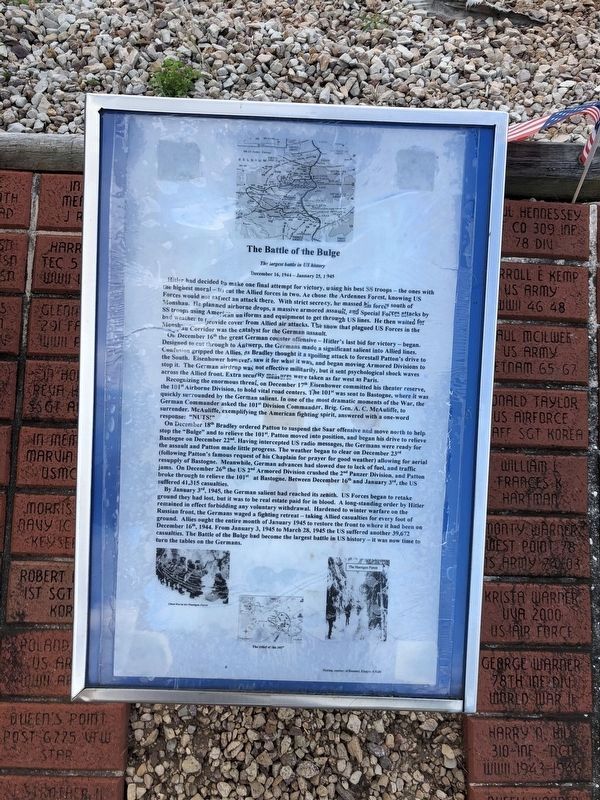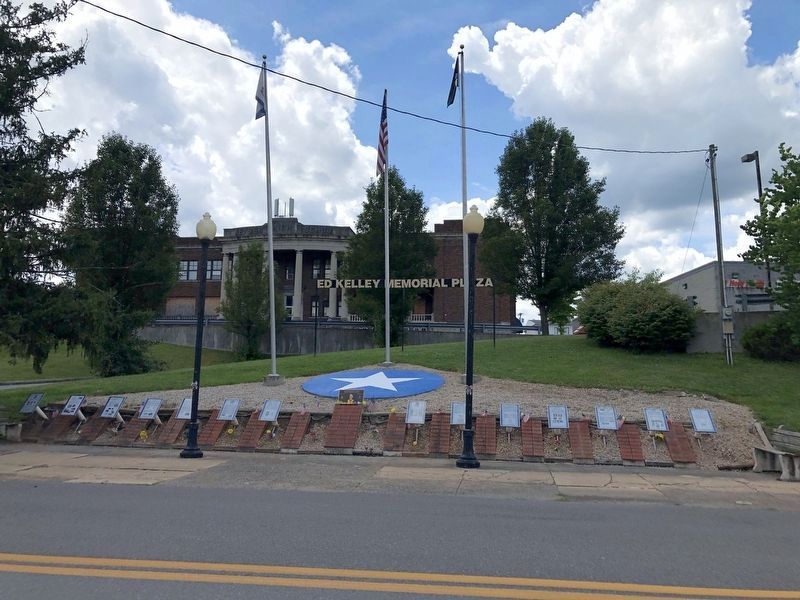Keyser in Mineral County, West Virginia — The American South (Appalachia)
The Battle of the Bulge
The largest battle in US history
— December 16, 1944 - January 25, 1945 —
Hitler had decided to make one final attempt for victory, using his best SS troops — the ones with the highest moral — to cut the Allied forces in two. He chose the Ardennes Forest, knowing US Forces would not expect an attack there. With strict secrecy, he massed his forces south of Monshau. He planned airborne drops, a massive armored assault, and Special Forces attacks by SS troops using American uniforms and equipment to get through US lines. He then waited for bad weather to provide cover from Allied air attacks. The snow that plagued US Forces in the Monshau Corridor was the catalyst for the German assault.
On December 16th the great German counter offensive — Hitler's last bid for victory — began. Designed to cut through to Antwerp, the Germans made a significant salient into Allied lines. Confusion gripped the Allies, as Bradley thought it a spoiling attack to forestall Patton's drive to the South. Eisenhower however, saw it for what it was, and began moving Armored Divisions to stop it. The German airdrop was not effective militarily, but it sent psychological shock waves across the Allied front. Extra security measures were taken as far west as Paris.
Recognizing the enormous threat, on December 17th, Eisenhower committed his theater reserve, the 101st Airborne Division, to hold vital road centers. The 101st was sent to Bastogne, where it was quickly surrounded by the German salient. In one of the most dramatic moments of the War, the German Commander asked the 101st Division Commander, Brig. Gen. A. C. McAuliffe, to surrender. McAuliffe, exemplifying the American fighting spirit, answered with a one word response: "NUTS!"
On December 18th Bradley ordered Patton to suspend the Saar offensive and move north to help stop the "Bulge" and to relieve the 101st. Patton moved into position, and began his drive to relieve Bastogne on December 22nd. Having intercepted US radio messages, the Germans were ready for the assault and Patton made little progress. The weather began to clear on December 23rd (following Patton's famous request of his Chaplain for prayer for good weather) allowing for aerial resupply of Bastogne. Meanwhile, German advances had slowed due to lack of fuel, and traffic jams. On December 26th the US 2nd Armored Division crushed the 2nd Panzer Division, and Patton broke through to relieve the 101st at Bastogne. Between December 16th and January 3rd, the US suffered 41,315 casualties.
By January 3rd, 1945, the German salient had reached its zenith. US Forces began to retake ground they had lost, but it was to be real estate paid for in blood. A long-standing order by Hitler remained in effect forbidding any voluntary withdrawal. Hardened to winter warfare on the Russian front, the Germans waged a fighting retreat — taking Allied casualties for every foot of ground. Allies ought the entire month of January 1945 to restore the front to where it had been on December 16th, 1944. From January 3, 1945 to March 28, 1945 the US suffered another 39,672 casualties. The Battle of the Bulge had become the largest battle in US history — and it was now time to turn the tables on the Germans.
Topics and series. This historical marker is listed in this topic list: War, World II. In addition, it is included in the Former U.S. Presidents: #34 Dwight D. Eisenhower series list. A significant historical date for this entry is January 3, 1945.
Location. 39° 26.383′ N, 78° 58.615′ W. Marker is in Keyser, West Virginia, in Mineral County. Marker is on West Piedmont Street (West Virginia Route 46) just west of North Davis Street, on the left when traveling west. Touch for map. Marker is at or near this postal address: 32 N Davis St, Keyser WV 26726, United States of America. Touch for directions.
Other nearby markers. At least 8 other markers are within walking distance of this marker. The First Battle of Kesternich (here, next to this marker); Regaining the Initiative (here, next to this marker); Key Terrain (here, next to this marker); D-Day (here, next to this marker); Jonah Edward Kelley (here, next to this marker); World War II (here, next to this marker); The Medal of Honor (here, next to this marker); Kelley Memorial Plaza (here, next to this marker). Touch for a list and map of all markers in Keyser.
Credits. This page was last revised on July 20, 2020. It was originally submitted on July 14, 2020, by Devry Becker Jones of Washington, District of Columbia. This page has been viewed 145 times since then and 23 times this year. Photos: 1. submitted on July 14, 2020, by Devry Becker Jones of Washington, District of Columbia. 2. submitted on July 14, 2020.

